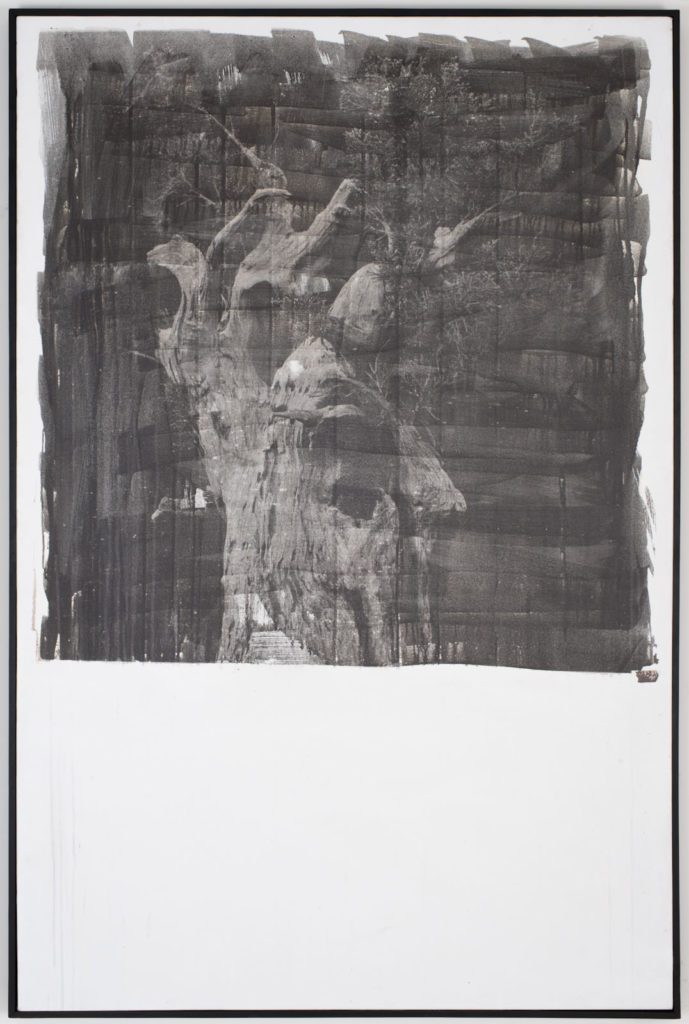Espacio liminal es una serie compuesta por seis cuadros de emulsión fotográfica sobre tela que plantean una reflexión sobre la reproducibilidad de la imagen fotográfica y su relación con la pintura. A partir de procesos de laboratorio, la tela es impregnada de emulsión fotosensible y procesada en cuarto oscuro de acuerdo a los procedimientos tradicionales de ampliación en blanco y negro, pero la aplicación de los químicos fundamentales del proceso se hace con brochas. Las imágenes resultantes son una fusión entre fotografía y pintura, pues conjugan la imagen del negativo y el lenguaje fotográfico subyacente a ellas con el gesto pictórico y la cualidad de unicidad de la pintura. En este sentido, los cuadros son fotografías no reproducibles y pinturas en blanco y negro a la vez, que se componen de la imagen fotográfica del proceso de ampliación y del acto mismo de pintar. Esta conjunción de lenguajes y medios apunta a poner en duda el carácter de verosimilitud de la fotografía, que se refuerza a su vez por la naturaleza de las imágenes ampliadas: los que parecen árboles monumentales son en realidad pequeños bonsáis extrapolados de su contexto, con una tela negra tras ellos que alude a la noche. Al no tener ningún referente que pueda servir de comparación para determinar su escala, los árboles adquieren otras dimensiones y cualidades. En la parte inferior de las composiciones se encuentra un espacio en blanco, el espacio liminal, reservado en la tradición del retrato para la notación explicativa de la imagen superior. Este espacio, en donde el texto hacía explícito quién era el personaje retratado, se encuentra vacío, pues su ausencia enfatiza la ambigüedad de la imagen y pone de manifiesto la necesidad del espectador por encontrar un referente textual ante una imagen problemática.
Liminal Space
Liminal Space is a series of six paintings made with photographic emulsion over canvas that addresses the problem of reproducibility of the photographic image and its relation to painting. After preparing a photosensitive emulsion, it is coated on a canvas that is then treated as photographic paper in a darkroom using the traditional chemicals for black and white enlargement, but the application of such chemicals is made with thick brushes in a way that establishes a direct connection with gesture and stroke. The resulting images are a mixture of photography and painting, since they fuse the image derived from the negative, and the photographic language underneath them, with the pictorial indexes and the uniqueness of painting. In this sense, these pictures are both non reproductible photographs and black and white paintings at the same time, which are made of the photographic image derived from the negative, the enlargement process and the act of painting in the dark. This fusion of languages and media questions photography’s credibility as a source of truth, which is supported also by the nature of the enlarged images themselves: The apparently large and monumental trees are in reality small bonsai trees taken out of their context with a black cloth behind them that resembles the night. Since there are no other objects in the picture that could provide a reference from which to determine the trees’ size, they assume other qualities and dimensions. Underneath the trees lies a blank space, the liminal space, used in the tradition of portraiture as an area reserved for notations that made explicit who the portrayed person was. The absence of text in this space emphasizes the ambiguity of the image above and also addresses the problem of the relation between photography and text: Were the spectator could expect to find some sort of notation that could provide an explanation for the image there is just a void space.






Espacio Liminal (Liminal Space)
Photographic Emulsion on Canvas structure and a screen
150 x 100
2013-2014
